Awake to a drizzly day. But I have no agenda! Does it matter that it's wet outside?
Breakfast comes to my room.
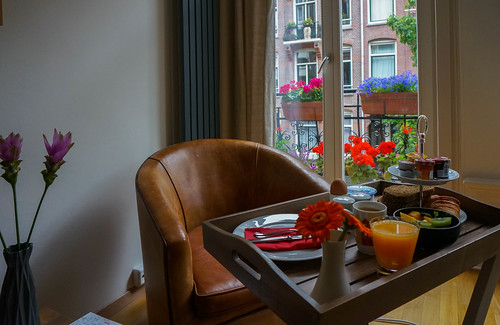
While waiting for it, I read a (very recent) cartoon-illustrated book about life in this city. When I first started traveling through here (1971), the city was just at the cusp of developing a new identity, guided by a liberal vision of tolerance toward everything from prostitution to gay culture to pot use. More than forty years later, it still remains the only city in Europe where you can walk into a coffee shop and buy some pot and walk out high.
Not that it's exactly legal to run these cafes. You can possess small quantities of pot, but you can't buy it and legally sell it. It's just that for now, the policy of nonenforcement is (shakily) in place. (In some Dutch cities, local ordinance prohibits cafes from selling to non-registered guests. To register, you need to live there. Amsterdam has declined to go that route, most likely because pot tourism brings good Euros to the city.)
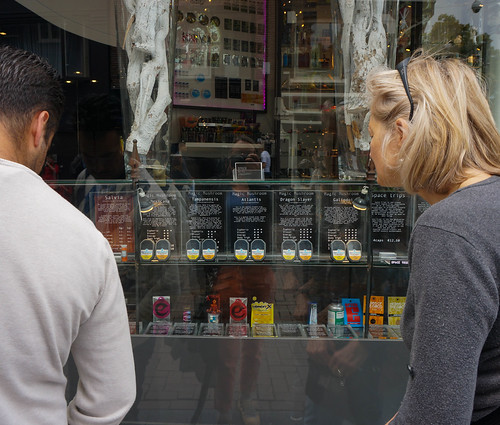
pausing to read about the different highs you can purchase
Supporters (of pot cafes) argue that cannabis is a soft drug, as opposed to, say, alcohol, which is a widely available hard drug. (Amsterdam is home to the Heineken brewery; here's a bar, one of many, celebrating this beer.)
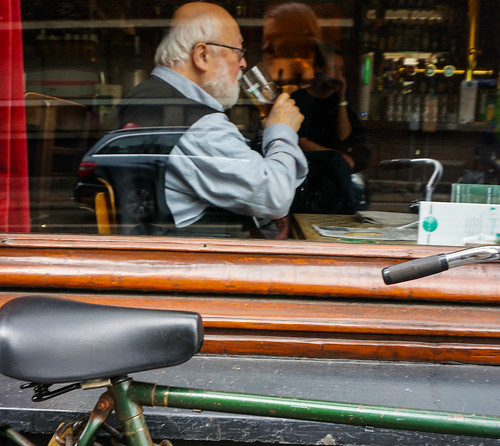
More interesting (than pandering to international pot tourism), I think, is the Dutch position toward hard drug users: don't punish, but give help. There are, for example, heroin clinics where you can apparently walk in and get a controlled amount so that you can gradually rid yourself of the habit. Heroin addiction here has greatly declined over the past several decades. Several countries are considering this "Dutch approach," though none have been bold enough to try it.
But this part of Amsterdam just passes me by. I read about it, I don't see it. Even in my younger years, I was more interested in traveling here from Poland to see the newly released movie the Love Story (not yet playing in Warsaw) than in hanging out on the square where the smell of pot was everpresent.
And I loved the museums here. And so on this wet and a bit cool day, I decide to go back to some favorite museums and to visit at least one new one, highly recommended by my hosts, Frank and Oki.
The drizzle comes and goes and as the day warms, I shed my jacket and play on/off with the umbrella. My first stop isn't far -- it's the Rijks Museum.

I'd say it would make the top ten list of Europe's greatest, but I'm not really inclined to linger. I just want to see the renovation (which, at ten years, took longer than the original construction; the place just reopened a year ago).
The lines to enter are legendary! But strangely, at 9:30 there are no lines at all and I breeze in without a pause. So of course, I trudge up to check off its most famous painting - the Night Watch. I mean, why not. I remember standing before it and reading to my then very young daughters about what to look for. And before that, standing alone as a young adult not knowing what to look for. Today, I scan it for those distant memories and I have to smile as they slowly trickle back to me.
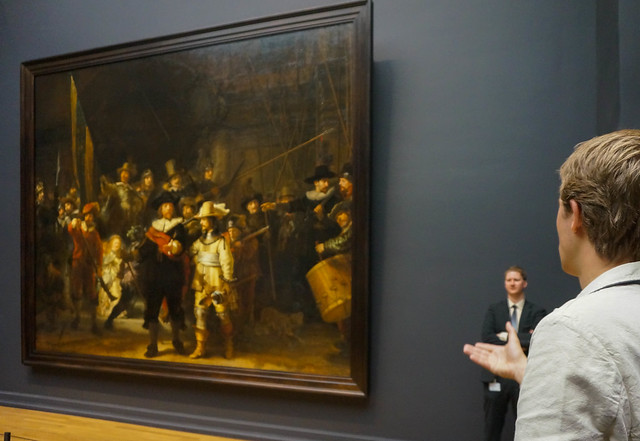
You're asking -- are you allowed to take photos inside the museum? The answer is yes. I don't know why even permanent collections in so many places are taking the position that you cannot photograph their stuff. (I'm remembering Paris at the Musee d'Orsay, for example.) Not that I plan on swamping you with favorites. Well, just a few. And you know why? For the same reason that, in the end, I stayed here a long time and I went through nearly the whole museum. And then returned for one more look at something I missed. And then returned for a third time to check on something else. Why? Well, there is (through September) a quite special, I think, commentary, posted throughout the museum on giant post-it like papers. Some of these "messages" are longer, but most are quite short.
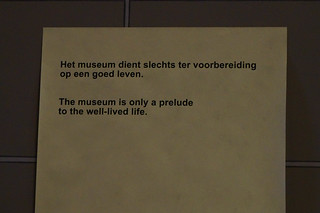
At first I didn't understand -- was this some unfinished business here? What are these comments? This next painting comes with the following (excerpted):
It is a picture that is geared to produce an ambivalent reaction. We delight in it and yet - at the same time - feel regret. We don't live up to the beauty of the picture. ... Rembrandt illuminates with painful accuracy our lack: we don't have nearly enough genuine love in our lives and in our world...
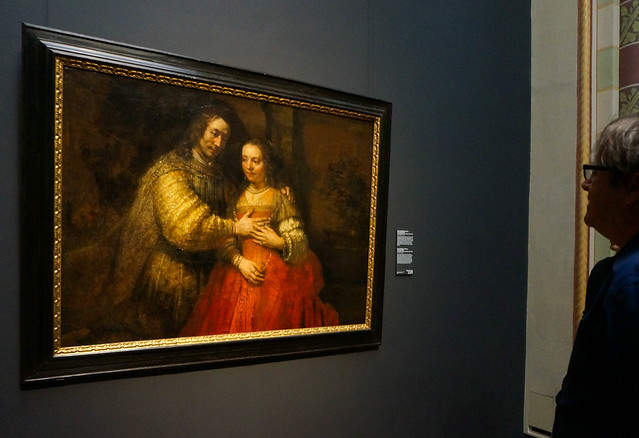
But I find myself reading them. And reflecting on them.
And only when I am done with the museum (the first time around), do I read downstairs that these were written by Alain de Botton -- the Swiss British philosopher whom I grew to admire some years ago when I read his sweet, sweet sweet book "How Proust Can Change Your Life."
De Botton writes not for the handful of like minded academical types, but for a wider audience and in just a few pages he really can set you spinning about the way you conduct your everyday affairs. I'd say Ocean is very much influenced by people like him. De Botton emphatically stands behind the relevance of small detail, the everyday minutia of life. In the Rijks Museum, here's what he says about this painting:
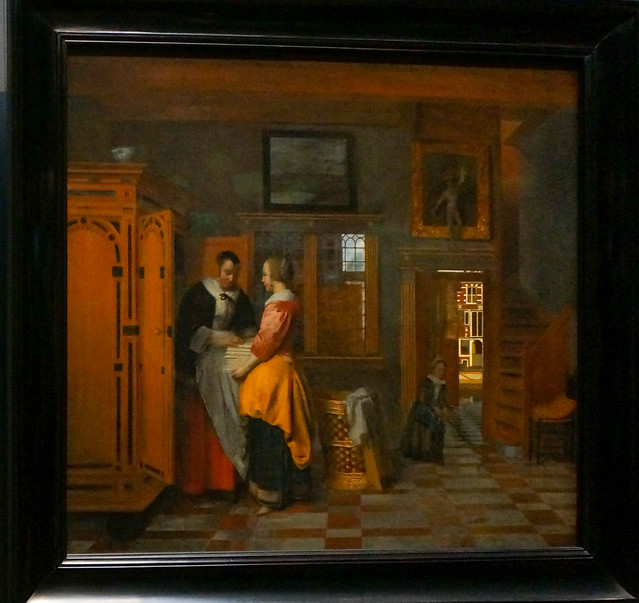
It can be hard to see beauty and interest in the things we have to do every day and in the environments in which we live. ... The linen cupboard itself could easily have been resented. It is an embodiment of what could, in unfavorable circumstances, be seen as boring, banal, and repetitive - even unsexy. If only we, like De Hooch, knew how to recognize the value of ordinary routine, many of our burdens would be lifted. It gives voice to the right attitude: the big themes of life - the search for prosperity, happiness, good relationships - are always grounded in the way we approach the little things...
And in a similar vein, on this one:
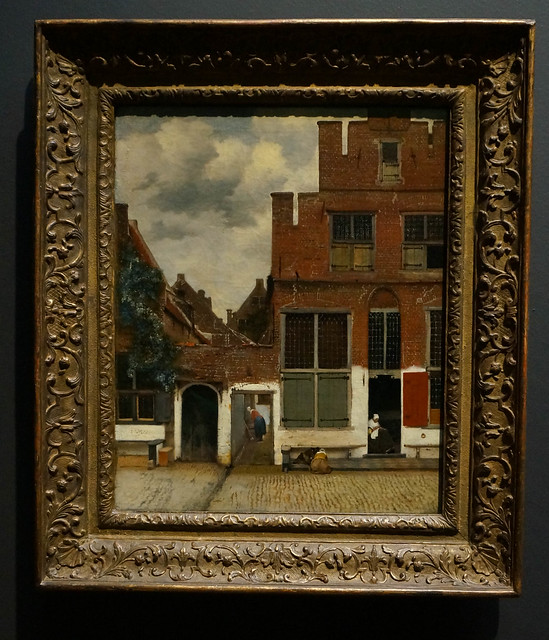
This painting...wants to show us that the ordinary can be very special. The picture says that looking after a simple but beautiful home, cleaning the yard, watching over the children, darning clothes - and doing these things faithfully and without despair - is life's real duty. This is an anti-heroic picture, a weapon against false images of glamour. It refuses to accept that true glamour depends on amazing feats of courage or on the attainment of status. It argues that doing the modest things that are expected of all of us is enough. ... If the Netherlands had a Founding Document, a concentrated repository of its values it would be this small picture. It is the Dutch contribution to the world's understanding of happiness - and its message doesn't just belong in the gallery.
All on large post-it type notes temporarily stuck on the walls of the museum. And so I am absolutely mesmerized by it all.
Now, some would say that de Botton only states the obvious. Yes, well, so do I, here on Ocean. I eat breakfast, tend to the farmette with Ed, watch daughters grow up. What could be more prosaic, banal, commonplace? But for me, this is life and if you can't pause to consider it, then you've let a lot of it slip by unnoticed, unrevered.
I'll leave you with a de Botton post-it and an a photo of the painting next to it, because being myself a life long fan of Impressionism, this really made me smile:
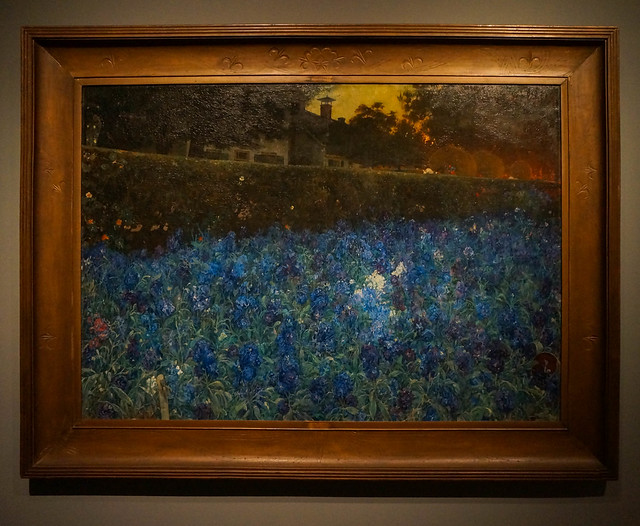
This is an unashamedly pretty picture, and educated people today quite often feel a bit queasy at the idea that art can be sweet and lovely. Isn't this a denial of all that is wrong with the world? Shouldn't art be about more weighty and worthy matters?
Van Looy knew a lot about human suffering - not least his own... Once life has shown us its darker sides, we start to take this sort of pretty scene more seriously. Beautiful flowers aren't a way of avoiding the tougher facts; they are a consolation now that we know what things are really like. We need beauty around us to keep up our spirits and to refresh our appetite for life. Cheerfulness - the mood that beauty naturally encourages - is a good state of mind to be able to access, given the number of practical problems we have to face. A taste for pretty art isn't a denial of the troubles of the world; it shows a wise awareness of the extent of suffering and a concern for bolstering oneself against despair.
Alright. I'm done. Out on the street, the rains have stopped. I head for the market, learning to dodge the bikes that come at you from every corner.

with roses
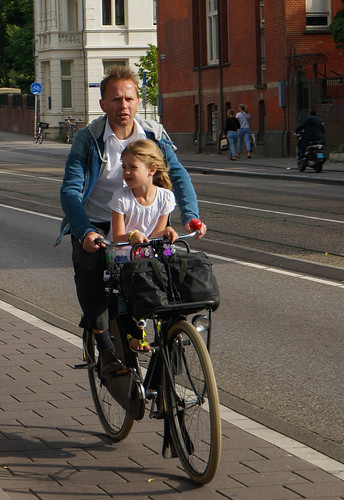
with a child
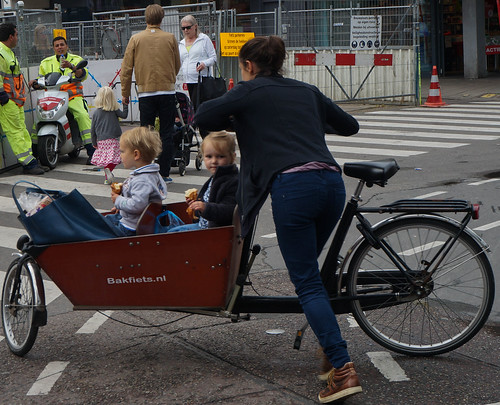
with more children
without helmets
Amsterdam has more bicycles than residents. Yes and they all drive crazily. I read that there are *only* a handful of bike deaths per year here. Typically trucks run down those in their blind spot. I suppose I should think that this low number is commendable, considering that some 10-20 men die here per year falling into canals as they try to pee into them while in a drunken stupor (they fall in and can't climb back out). Ahhh, but Amsterdam is a dangerous city for those who don't watch their step!
But, too, it is a pretty city. Let's not forget that.
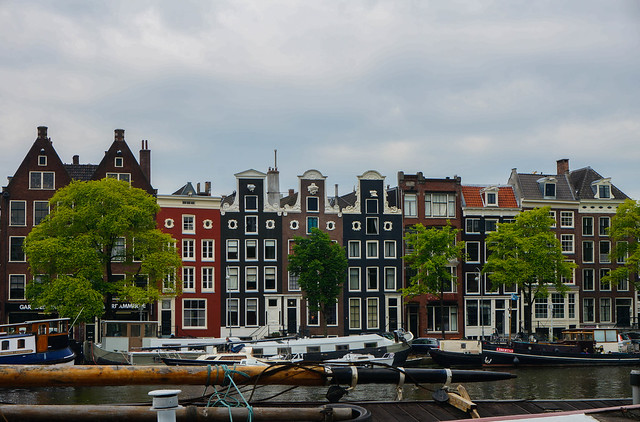
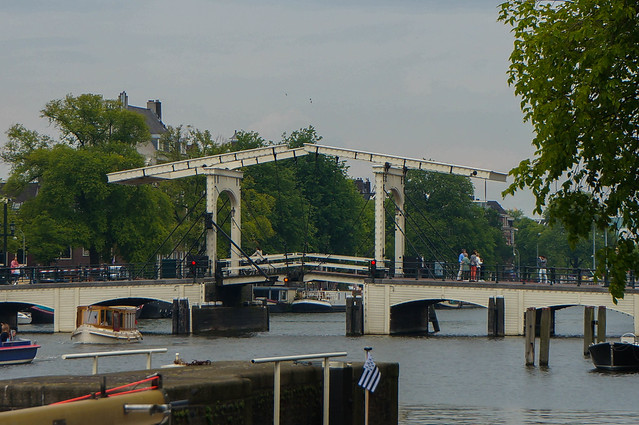
I make another museum stop in the early afternoon -- the Hermitage. Museum nuts will recognize the name as belonging to perhaps the world's richest art gallery -- the Hermitage in St Petersburg. Well now, Amsterdam has opened a branch of it with rotating collections from the real deal.
But I change my mind once I enter the museum. This year's collection is on art along the Silk Route and my head is still reeling with Vermeers and Rembrandts. So instead, I go straight to their brand new cafeteria, pick a plate of boiled new potatoes with Norwegian smoked salmon and sit down at a long table that has very attractive glossy magazines from Russia (among other places).
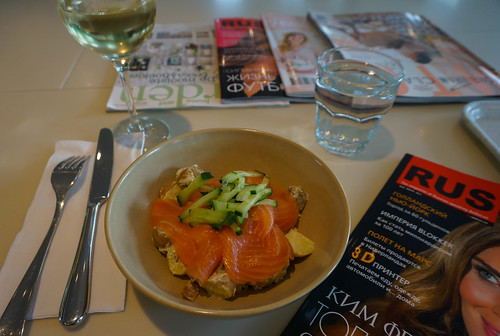
It is a fitting tribute to that country's world of art (and food: I think of boiled potatoes as being very Russian. Or Polish. Or both).
In the evening, I go out again. My first stop is the Seafood Bar. My hosts Oki and Frank tell me to reserve if I want to eat there, but heck, that place is booked weeks in advance. The best you can do is show up for the handful of spots that are given to walk-ins. Being single, I am squeezable. A place is set at the bar for me.
I order a mixed grill, because this is a seafood country and besides, after yesterday's vegetable stew, I need to move away from local fresh, honest and bland.
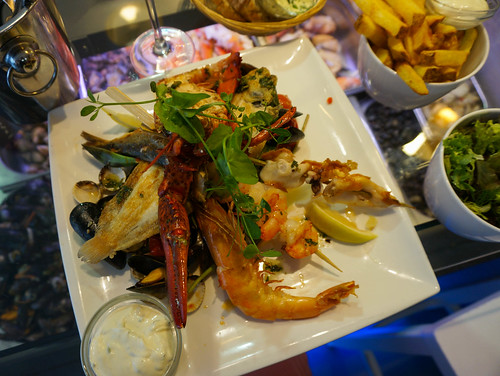
It's a delicious dinner and I really don't know how it is that this same concept of mixed seafoods is so differently executed in different parts of the world even as the basic ingredients -- shrimp, fish, etc -- are nearly the same.
At one side of me, I have a couple from Finland. Actually he is from Finland, she is from Thailand. We exchange first pleasantries, then stories and she looks at me and asks me how come I'm so muscular (!) and I look at her and wonder what she is doing all the way up in Finland and before you know it we're FB friends and exchanging daughter stories and pictures.
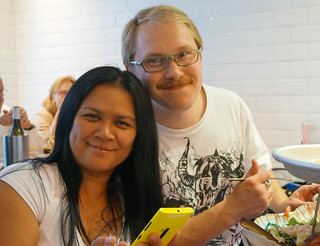
I mention this because eventually all roads do lead to stories from home. You may think you're away and yet, sooner or later your life catches up with you and you are right back where you started. This became even more evident as the evening progressed. The Finish-Thai couple were explaining how Finish people don't drink daily, but when they do drink, they do so to get drunk. I reflected how perhaps the same can be said of Poles. A flushed young man from behind the counter emphatically disagrees. In Polish. Not anymore! Things are different now! -- he says with some agitation.
It turns out he is Polish and he feels compelled to stick up for his own people, even though I'm Polish as well and have always found that critical comments about Poles are far easier to take if they come from Poles rather than outsiders. Still, I consider myself fully caught, proving once and for all that you're never safe in speaking of your own cousins or neighbors: they could well be the persons shucking oysters behind the counter.
And now it truly is evening and I should really head home, but instead, I head for the Van Gogh Museum which coincidentally on this day is open until 10 p.m. I thought surely at 8:30 it would be rather on the empty side. (Last time I was here it was so packed, I was three people removed from any of the art works.)
It is quite uncrowded, but if I thought I'd have another soulful museum experience, I was wrong. This particular museum is a bit like the Guggenheim in New York in that it's an open space with tiered layers of exhibition. If you want to proceed chronologically, you start at the bottom and work your way up. (I know, I know, it should be the opposite, but there you have it.)
Well now, there is a concert of sorts taking place on the ground floor. Some pop type event that was tied into Van Gogh, because the upper walls are occasionally flooded with images of the artist and/or his work.
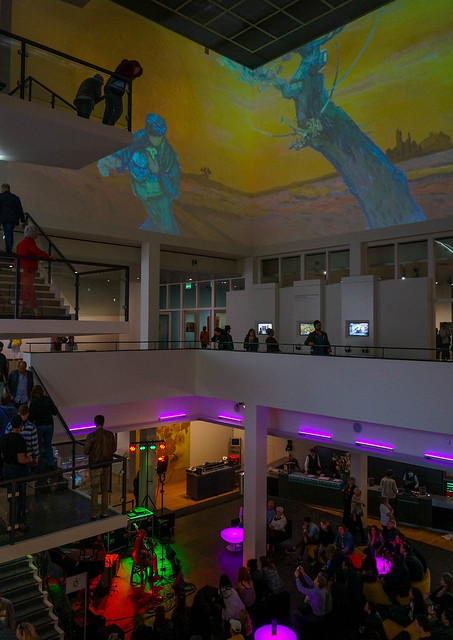
Maybe some would find this moving. I found it to be more theatrical and loud than anything else. So I strolled up and then I strolled down and since cameras are not permitted, you'll see none of the canvases which surely is okay as they're all familiar pieces to anyone who cares at all about Van Gogh or Impressionist art.
Despite all this, I walk home satisfied. For a visit that lasts really not even two days, I have had my fill of Amsterdam for now. Perhaps it's the way we position ourselves: I'm here a short time and so I don't fully engage in all aspects of the city. Too, I find Amsterdam to be loud and crowded in its youthfulness. Not only are the residents younger, so are the visitors (30% are between 20 and 29). Barcelona is also loud, but you can find quiet deep in the neighborhoods that spread away from the center. Amsterdam, too, surely has its quiet corners, but it's not where you and I would walk. Or ride. Ah, yes: the whizzing bikes, forever passing you in that death defying race from one block to the next...
So I'm satisfied. Two days was grand. Tomorrow, I fly even further north.


This post moved me to tears. Thank you for noticing these things and not letting them go by unrecorded.
ReplyDeleteThis comment has been removed by the author.
ReplyDeleteIt was at the Rijks that I discovered Vermeer. "Woman in Blue Reading a Letter" simply stunned me, and as I went through the museum, I found myself heading back to see it several times. And of course there's "The Night Watch," impressive for its size and fame. Still, Vermeer does it for me: a whole multi-layered narrative in each painting.
ReplyDeleteMy philosophy, lovingly articulated, thank you for this enriching post. Books by deBotton already reserved.
ReplyDeleteSo, when I first same to your blog, Nina, I felt the "ah" of recognition and knew that combination of joy and serenity that is your daily approach to life. I told you that "I like you"! Well. It's more complicated than that. More a sort of recognition.
Ocean readers couldn't have a better tour guide, or traveling companion.
Love, love, love, LOVE the De Botton comments. I wish he could write them for all museums. xo
ReplyDeleteWhat JoyD said.. it was all perfectly lovely and I thank you for writing it - and doing it - and sharing it. I loved the museum where you could photograph the art. Thanks again! xxx
ReplyDeleteIf I can spell Alain de Botton correctly. I could note had has posted comments in the gallery here in Melbourne. (There's one of his Schools of Life her). I love his book The At of Travel. So much to reflect on. Jean
ReplyDelete